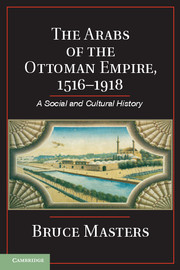Book contents
- Frontmatter
- Contents
- Acknowledgments
- Abbreviations
- Note on Transliteration
- Introduction
- 1 The Establishment and Survival of Ottoman Rule in the Arab Lands, 1516–1798
- 2 Institutions of Ottoman Rule
- 3 Economy and Society in the Early Modern Era
- 4 A World of Scholars and Saints
- 5 The Empire at War
- 6 The Tanzimat and the Time of Re-Ottomanization
- 7 The End of the Relationship
- Conclusion For the Faith and State
- Bibliography
- Index
- References
1 - The Establishment and Survival of Ottoman Rule in the Arab Lands, 1516–1798
Published online by Cambridge University Press: 05 April 2013
- Frontmatter
- Contents
- Acknowledgments
- Abbreviations
- Note on Transliteration
- Introduction
- 1 The Establishment and Survival of Ottoman Rule in the Arab Lands, 1516–1798
- 2 Institutions of Ottoman Rule
- 3 Economy and Society in the Early Modern Era
- 4 A World of Scholars and Saints
- 5 The Empire at War
- 6 The Tanzimat and the Time of Re-Ottomanization
- 7 The End of the Relationship
- Conclusion For the Faith and State
- Bibliography
- Index
- References
Summary
The Ottoman Empire expanded into the lands that today compose most of the member states of the Arab League during the reigns of Selim I (1512–20) and Süleyman (1520–66). The empire had already achieved major successes in the Balkans and Anatolia when its forces moved south in 1516. The conquest of the Arab lands marked, however, a significant geopolitical shift in the empire’s territorial expansion from the European periphery of the Dar al-Islam (“The House of Islam,” i.e., the lands under Muslim rule) into its historic heartland. The campaigns of the sixteenth century brought the fabled cities of Baghdad, Damascus, and Cairo under the dynasty’s rule. The first two cities enjoyed prestige among Sunni Muslims as having once served as the seat of the caliphate, while a titular caliph still held court in Cairo when the Ottoman army arrived. The new territories also included Islam’s three holiest cities: Mecca, Medina, and Jerusalem. Highlighting that responsibility and the honor it conferred upon him, Selim added the title “Servitor of the Two Holy Places” to the long list of titles he already held. His son Süleyman could boast, “I am Süleyman, in whose name the hutbe [Friday sermon] is read in Mecca and Medina. In Baghdad I am the shah, in Byzantine realms the Caesar, and in Egypt the sultan.”
- Type
- Chapter
- Information
- The Arabs of the Ottoman Empire, 1516–1918A Social and Cultural History, pp. 20 - 47Publisher: Cambridge University PressPrint publication year: 2013



